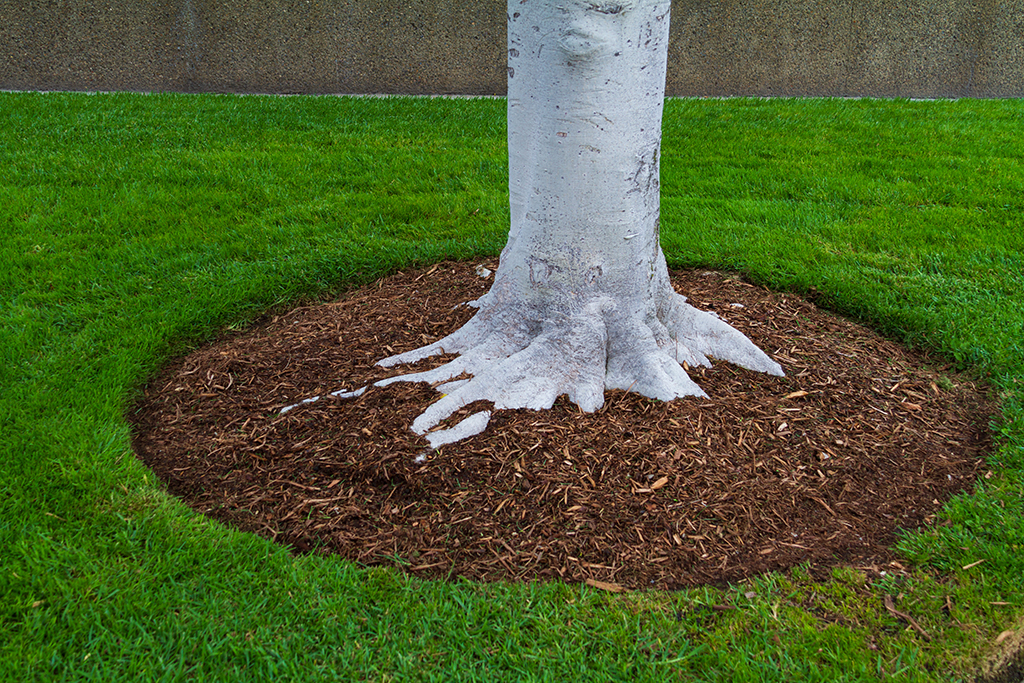Do I Need to Place Mulch Around Trees? Tips from Your Fort Worth, TX Tree Service
Photo By Felipe_Sanchez at Shutterstock
Mulches are materials spread over the surface of soil to serve functional and aesthetic purposes. A layer of mulch helps soil retain moisture and improves overall soil conditions. Mulch enhances aesthetic appeal of a home, yard, or garden. It gives planting beds, trees, and garden paths a uniform, well-groomed appearance. Tree service providers in Fort Worth, TX, usually offer landscaping services too. Mulch can be incorporated into an overall landscape design.
Mulching is a very cost-effective project with many benefits to augment tree health. It protects tree roots from heat, cold, and drought conditions. The mulch itself provides extra nutrients as it decomposes. It is important to use mulch that provides benefits for the trees it surrounds. Different types of trees need a variety of soil requirements to help them thrive. Mulching materials also need to be appropriate for the climate in Fort Worth, TX. A tree service is a great resource for information and recommendations for mulching materials.
Mulching Material Characteristics
Mulch contributes to a stable environment to encourage root growth from newly planted trees or maintain healthy and vigorous mature trees. Trees depend on their root systems for water and nutrients. A thin layer of mulch spread over a broad area increases moisture content in soil. The mulch also functions as an insulating blanket to shields tree roots from extreme temperatures. Mulch holds warmth in the soil during winter and blocks heat during hot, sunny summers in Fort Worth, TX.
A 2 to 4-inch layer of organic mulch is the generally accepted standard depth on urban landscapes. It recreates properties of natural environments and inhibits weed germination and growth. Transporting mulch can be a problem for people without vehicles to haul it in. A tree service in Fort Worth, TX, can deliver and install mulch or simply deliver it for customers to place for themselves.
It is best to consult tree service professionals before trying a mulching project for the first time. Mulch needs to be used correctly to provide benefits, and some mulching materials actually harm trees and other plants. Excessively deep mulch layers can hold too much moisture in the underlying soil. The extra moisture in the root zone, or the layer of soil where most tree roots exist, may contribute to root rot.
The texture of mulching material affects its properties. Fine particles frequently become tightly packed and hold moisture within the mulch itself instead of letting it reach the soil. The moisture evaporates before it ever reaches tree roots. Mulch with a coarse texture is too porous to retain sufficient amounts of moisture. Organic mulching materials slowly decompose into nutrient-dense humus that transfers nutrients to the underlying soil.
Organic mulch should be composted before use to make sure that unwanted seeds, microorganisms, and insects can not contaminate the soil underneath the mulch layer. The composting step is especially important for mulch that has been sitting unused for any length of time or mulch from unknown sources. Mulch obtained from a tree service provider is probably already composted and ready for use upon delivery.
Types of Mulch
Organic mulch is available in many different materials. Grass clippings are dried and composted to make them suitable for mulching. Grass clippings are dense and form thick mats when used alone, so additional materials are necessary to make the mulch more porous. Grass is a rich source of nitrogen, but it has high alkalinity.
Cedar and cypress are common wood mulch options. Cedar oil repels insects and keeps them away from the tree’s base. Cypress repels insects too, but it is not as effective as cedar. Both cedar and cypress decompose slowly. They form long-lasting mulch, but their nutrient contribution is negligible. The oils in cedar and cypress are not always beneficial for shrubs and trees. A tree service professional can offer advice for using cypress or cedar chips.
Pine needles are good mulching material for trees that prefer acidic soil. A bed of pine mulch is very distinct and draws attention. Pine boughs are sometimes used as winter mulch. They add a festive air to the landscape for winter holidays and provide additional insulation as a top layer over a mulch bed.
Straw is a good winter mulch because it is an excellent insulator. It also adds a copious amount nutrients to soil as it decomposes. Hay can be used as mulch too, but it usually contains more weeds and seeds than straw. Straw is usually packaged in lightweight compressed bales.
Bark mulch has a consistent, pleasant color. It is usually cheap and plentiful. Hardwood bark is available shredded or in large chips. Tree service providers typically carry several types of bark mulch. Both options are porous and let water and air move freely. Bark chips are heavier than most other mulching materials. The extra weight is beneficial during stormy weather in Fort Worth, TX, when high winds may blow lighter mulching materials all over a yard or property.
Leaf mold mulch is made out of composted dead leaves. It is packed with nutrients that transfer to soil as the leaves decompose. Animal manure is extremely rich in nutrients, although it is not always considered mulching material. Manure should be carefully mixed with other materials to avoid burning delicate roots or a tree’s trunk. A professional tree service provider can provide guidance for mixing manure with other materials safely.
Sawdust and sewage sludge are mulching materials that are very popular in some regions and almost unheard of in others. Sawdust is combined with substances that are rich in nitrogen such as manure or fertilizer. Sewage sludge is packed with nutrients, but it has to be mixed with other mulching materials. Contact a S&P Tree Service for pre-mixed mulch including sewage sludge.


